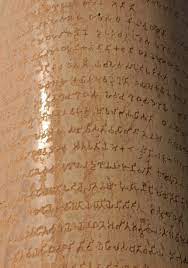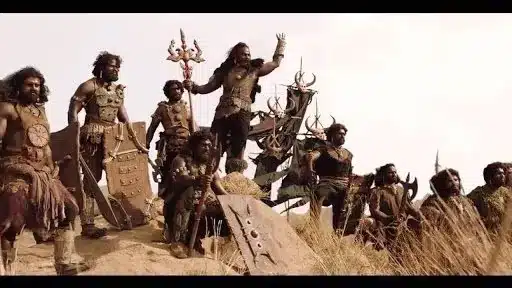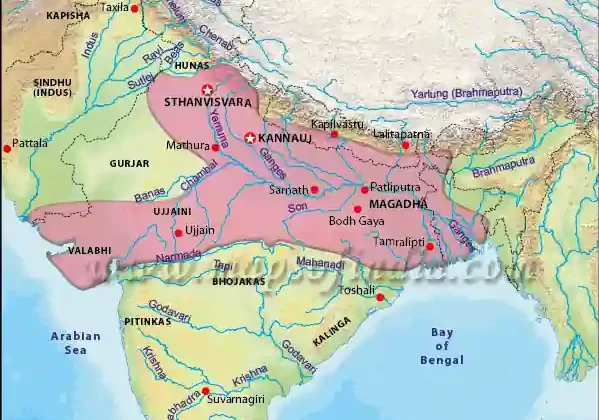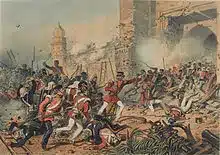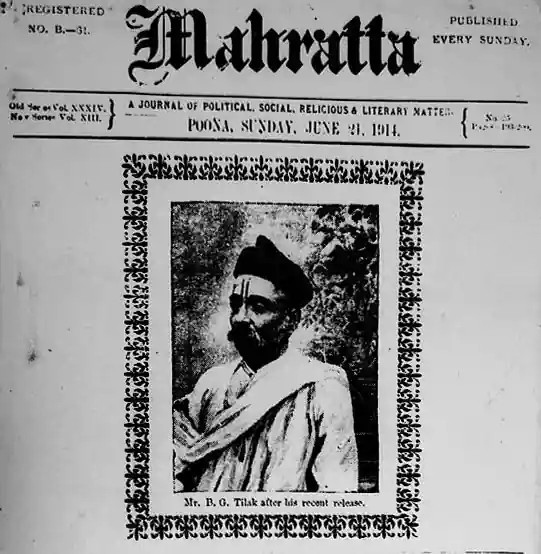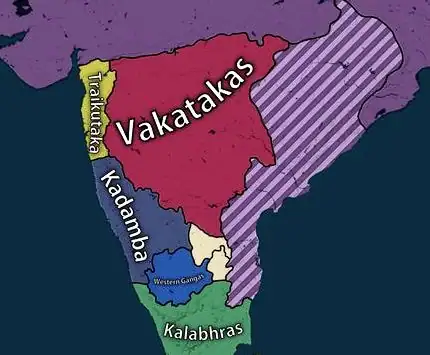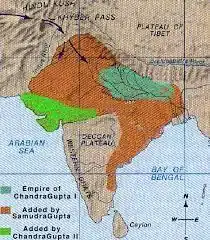The Satavahanas
- Maurya’s rule was succeeded by the Sungas and the Kanvas in the north. However, in Deccan and in central India, the Satavahanas succeeded the Mauryas though after a gap of almost 100 years.
- The only dynasty in India that ruled for the longest period, uninterrupted for 400 years by 33 Satavahana kings from 2nd Century B.C. to 2nd Century A.D.
- Their first capital city was Paithan (also known as Pratisthanapura) in Maharashtra and second capital city was Dhanyakatak or Amaravathi.
- The Matsya Purana mentions that the Andhra dynasty ruled for around 450 years.
- The earliest Satavahana inscriptions belong to the 1st century BCE, when they defeated the Kanvas and established their rule over parts of central India.
- It is also pertinent to note that the early Satavahana kings appeared not in Andhra but in north Maharashtra (the fertile basin of the upper Godavari valley), where their earliest coins and inscriptions have been found.
- Gradually, they extended their power over Karnataka and Andhra.
- They were also known as the Andhras.
- The Puranas and inscriptions remain important sources for the history of Satavahanas.
- However, interestingly, neither the name Andhra appears in Satavahana inscriptions, nor do the Puranas speak of the Satavahanas (only refer to Andhras).
- According to some Puranas, the Andhras ruled for 300 years with their capital at Pratishthana (modern Paithan) on the Godavari in Aurangabad district. This is also the period designated to the Satavahana Dynasty.
- Among the inscriptions, the Nasik and Nanaghad inscriptions throw much light on the reign of Gautamiputra
- Satakarni.
- The coins issued by the Satavahanas are also helpful in knowing the economic conditions of that period.
- The founder of the Satavahana dynasty was Simuka and was succeeded by Krishna, who extended the kingdom up to Nasik in the west.
- The third king was Sri Satakarni. He conquered western Malwa and Berar. He also performed asvamedha sacrifices.
- The seventeenth king of the Satavahana dynasty was Hala. He reigned for a period of five years. Hala became famous for his book Gathasaptasati, also called Sattasai. It contains 700 verses in Prakrit language.
- The Satavahanas claimed Brahmana descent and performed Vedic rituals and worshipped gods like Krishna, Vasudeva, as evident in the Naneghat cave inscription of Naganika (1st century BCE), which mentions the great sacrifices performed by Satkarni I.
- Another striking feature of the kings pertaining to this dynasty was that they used matronyms such as Gautamiputra and Vashishthiputra, although they were not matrilineal or matriarchal in any sense. The Satavahanas assumed the title of Dakshinapathapati (Lord of the Dakshinapatha).
- Their greatest competitors were the Shaka Kshatrapas of Western India, who had established themselves in the upper Deccan and western India. Control of the prominent seaports such as Bhrigukachcha (Broach), Kalyan, and Suparaka (Sopara) must have been a bone of contention between the two.
- The Satavahanas are also known in history for starting the practice of giving royal grants of land to Brahmanas and Buddhist monks, including those associated with tax exemptions. It is mentioned in one of the inscriptions of Gautamiputra Satkarni that the land gifted to the Brahmanas was not to be entered or disturbed by the royal troops, was not to be dug for salt, was free from the control of state officials, and was to enjoy all sorts of pariharas (immunities). They also promoted Buddhism by granting land to the monks.
Important Rulers of Satavahana Dynasty
Simuka
- Founder of the Satavahana Dynasty and was immediately active after Ashoka’s death.
- The various Puranas state that the first king of the dynasty ruled for 23 years, and mention his name variously as Sishuka, Sindhuka, Chhismaka, Shipraka, etc.
- According to the Puranas, the first Andhra king overthrew the Kanva rule.
- Built Jain and Buddhist temples.
Satakarni I
- Satakarni I was the real founder of the dynasty.
- He was also the first king in South India to perform Aswamedha sacrifice.
- He was defeated by Kharavela of Kalinga.
- The Nanaghat inscription issued by his wife, Naganika talks about his greatness.
Hala
- Hala was the scholarly king who wrote the famous Gadhasapta Sathi (700 stories) in Prakrit language.
- The Matsya Purana mentions him as the 17th ruler of the Satavahana dynasty.
- Gunadhya was the court poet of Hala who wrote the famous Brihatkatha-manjari in Paisachi language.
- It narrates the story of Naravahanadatta (Kuber – the God with Nara’ as vehicle).
Gautamiputra Satakarni
- The greatest ruler of the Satavahana dynasty was Gautamiputra Satakarni. He ruled for a period of 24 years from 106 to 130 A.D.
- He founded the Salivahana era in 56 A.D.
- It appears initially the Shaka Kshatrapas of Western India succeeded in dislodging the Satavahanas from the western and central region, but later the fortunes of the Satavahanas were revived by its most famous ruler, Gautamiputra Satkarni.
- He not only defeated the Shakas but also raised the power and prestige of the Satvahanas to greater heights.
- It was under his reign that the empire was at its peak.
- He claimed to have destroyed the Kshaharta lineage. His victory over Nahapana, the ruler of Malwa was remarkable.
- His empire extended from Malwa in the north to Karnataka in the south, having general authority over the present day Andhra region.
- His achievements are described and eulogised after his death, during his son Pulumayi II’s reign, in a Nashik Inscription of his mother Gautami Balashri (written in Prakrit).
- In this inscription, he is described as the destroyer of the Shakas, Pahlavas, and the Yavanas, as the uprooter of the Kshaharatas and as the restorer of the glory of the Satvahanas.
- In the Nashik inscription, he is also described as ekabamhana (a peerless Brahmana) and khatiya-dapamanamada (one who destroyed the high handedness and pride of the Kshatriyas).
- He took the titles-Ek Brahmin (The only Brahmin) and Trisamudradiswar (The Lord of Three Seas).
- He donated land to the Buddhist monks, the Mahasamghikas, at Karle (the Karle Inscription mentions the grant of ‘Karajika‘ village near modern Pune, Maharashtra) and at Nashik (as evident in the Nashik Inscription, dated in the 18th year of Gautamiputra’s reign which mentions that this piece of land was earlier in the possession of Nahapana’s son in law Ushavadata).
- He assumed title of Rajaraja and Maharaja.
- In the later period of his reign, he probably lost some of the conquered Kshaharata territories to the Kardamaka line of the Shaka Kshatrapas of Western India, as evident in the Junagadh Inscription of the Rudradaman I.
Vashishtaputra Pulamayi (c. 130–154 CE)
- Gautamiputra Satakarni was succeeded by his son Vashishtaputra Pulamayi.
- The Shakas Kshatrapas of Western India probably recovered some of their territories due to his engagements in the east.
- According to the Junagadh Inscription, he married the daughter of Rudradaman I.
- His coins are found in the various parts of Andhra.
- He extended the Satavahana power up to the mouth of the Krishna river. He issued coins on which the image of ships was inscribed. They reveal the naval power and maritime trade of the Satavahanas.
Yajna Sri Satakarni (c. 165–194 CE)
- The last great ruler of Satavahanas was Yajna Sri Satakarni.
- One of the later kings who recovered north Konkan and Malwa from the Shaka rulers.
- Lover of trade and navigation, as evident from the motif of the ship on his coins.
Later Satavahana Rulers
- The successors of Yajnashri Satakarni included Gautamiputra Vijaya Satakarni, Chanda Satakarni, Vasisthiputra Vijaya Satkarni, and Pulumavi.
- Pulumavi IV, the last king of the main line, ruled until c. 225 CE. During his reign, several Buddhist monuments were constructed at Nagarjunakonda and Amaravati.
- In the mid-3rd century CE, the Satavahana dynasty came to an end and various forces came into power in their stead: the Vakatakas in the Deccan, the Kadambas in Mysore, the Abhiras in Maharashtra, and the Ikshvakus in Andhra emerged as the main rulers.
Important Aspects of the Satavahanas
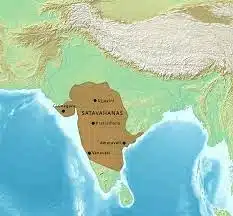
Polity and Adminstration
- The Satavahanas retained some of the administrative units of Ashokan times.
- The kingdom was divided into subdivisions called aharas or rashtras, meaning districts.
- There were also officers called amatyas/mahamatras who were perhaps ministers or advisors of the king. But, unlike Mauryan times, certain military and feudal traits are found in the administration of the Satavahanas. For instance the senapati was appointed provincial governor. It was probably done to keep the tribal people who were not thoroughly Brahmanised under strong military control.
- The lowest level of administration was a grama (village), which was under the charge of a gaulmika (village headman), who was also the head of a military regiment consisting of nine chariots, nine elephants, 25 horses and 45 foot soldiers.
- The military character of the Satavahanas is also evident with the use of terms like kataka and skandhavaras in their inscriptions, which denote military camps and settlements attached to a particular king and also served as administrative centres.
- The Satavahana kingdom had three grades of feudatories:
- Raja (who had right to strike coins)
- Mahabhoja
- Senapati
- Revenue was collected both in cash and kind.
- The Satavahana kings were the first in Indian history to make tax-free land grants to Buddhists and Brahmanas to gain religious merit. This practice became more prominent in succeeding periods.
- The importance of land revenue for the king can be judged from the elaborate procedure that was used to record donations of land. These donations were first proclaimed in an assembly or nigama-sabha. It was then written down either on a copper plate or cloth by an officer or minister and thus, detailed account of these donations were maintained.
Material Culture
- As the Satavahanas acted as a bridge between North and South India, similarly their material culture was a fusion of both local Deccan elements as well as northern ingredients. Through contacts with the north, the people of Deccan learnt the use of coins, burnt bricks, ringwells, the art of writing, and so on.
- There was regular use of fire-baked bricks and the use of flat, perforated roof tiles which must have aided in the longevity of the construction. For instance, in Karimnagar, as many 22 brick walls have been discovered.
- The drains were covered and were also underground to lead waste water into soakage pits.
- They were also fairly acquainted with the use of iron and agriculture. They probably exploited the rich mineral resources of Deccan such as iron ores from Karimnagar and Warangal and gold from Kolar fields.
- Unlike the gold coins of the Kushanas, they mostly issued lead coins (which they probably imported from the Romans) apart from copper and bronze coins.
- The Deccan developed a very advanced rural economy. The people knew about the art of paddy transplantation and especially in the area at the confluence of the rivers Krishna and Godavari formed a great rice bowl.
- The Satavahanas also produced cotton and in different foreign accounts, Andhra was famous for its cotton products.
Social Organisation
- Since the Andhras are identified with the early Satavahanas, they were probably a local Deccan tribe who were gradually Brahamnised.
- The Satavahana kings (such as Gautamiputra Satkarni) claimed to be Brahmans and considered it their primary duty to uphold the varna system, that is, the four-fold division of social structure determined by caste.
- Kings and queens performed Vedic sacrifices and worshipped Vaishnava gods such as Krishna and Vasudeva. Though they made liberal sacrificial fees to the Brahmanas, they also promoted Buddhism by granting land to Buddhist monks, especially to Mahayana Buddhists.
- Nagarjunakonda and Amravati in Andhra Pradesh and Nashik and Junar areas of Maharashtra became important Buddhist sites under the Satavahanas and their successors, the Ikshvakus.
- Merchants generally named themselves after the towns to which they belonged.
- Both artisans and merchants made generous donations to the Buddhist cause.
Architecture
- During the Satavahana phase, many chaityas (sacred shrines) and viharas (monasteries) were cut out of the solid rock in the north-western Deccan or Maharashtra with great precision and skill.
- The Karle Chaitya in the western Deccan belongs to this era.
- The Nashik inscriptions of Nahapana and Gautamiputra Satakarni, which are on the walls of the three viharas , is another important architectural site belonging to this period.
- The official language of the Satavahanas was Prakrit, though the script was Brahmi. One famous Prakrit text, Gathasattasai, is attributed to a Satavahana king called Hala, which consisted of 700 verses all written in Prakrit.
Economic Condition
- There was remarkable progress in the fields of trade and industry during the Satavahana rule. Merchants organized guilds to increase their activities.
- The craft guilds organized by different craftsmen such as potters, weavers and oil pressers also came into existence.
- Silver coins called Karshapanas were used for trade.
- The Satavahana period also witnessed overseas commercial activity.
- Ptolemy mentions many ports in the Deccan.
- The greatest port of the Satavahanas was Kalyani on the west Deccan.
- Gandakasela and Ganjam on the east coast were the other important seaports.
- Traders and merchants figure prominently as donors, but also important are blacksmiths, gardeners and
- fishermen.
- The artisans and craftsmen benefited from the increased long-distance trade.
- The artisans mention their occupations with their names and not their castes.
- Another important development of the period was the frequent mention of the yavanas or foreigners as the donors.
Cultural Contributions
- The Satavahanas patronized Buddhism and Brahmanism and built chaityas and viharas.
- The Satavahana kings donated large sums of money and land to the Buddhist monasteries and this added to the wealth of the sangha.
- Vashishtaputra Pulamayi repaired the old Amaravathi stupa.
- Brahmanism was revived by the Satavahanas along with the performance of asvamedha and rajasuya sacrifices.
- The Satavahanas also patronized the Prakrit language and literature. Hala’s Sattasai is an excellent piece of Prakrit literature.
- Women frequently made gifts either on their own or sometimes with their husbands or sons. One of the Satavahana queens named Nayanika also performed Vedic sacrifices and made large donations to the Brahmana and Buddhist monks.
- It is clear from various sources that the society was not governed by rules laid down by the Brahmanical texts and Buddhist traditions might have had some sway on society.
- The social structure of the Deccan under the Satavahanas shows many features which are different from those prescribed in the Sanskrit texts such as the Manurmriti.
- Many inscriptions of the Satavahana rulers mention the names of their mothers rather than those of their fathers, such as Gautamiputra Satakarni or Satakarni, son of Gautami. This is not in keeping with the Dharmasastras which state that in the approved forms of marriage, the bride acquires the gotra of her husband and loses that of the father.
- In the inscriptions the Satavahanas refer to themselves as unique Brahmanas who crushed the pride of the Kshatriyas (according to the Brahmanical texts it was only the Kshatriyas who had the right to rule).
- The inscriptions are also useful as they record donations by a cross-section of the population and from this the prosperity of certain sections of the society can be judged.
Importance of Satavahana Period
- Offering land grants was an important development of the Satavahana times.
- The beneficiaries of these grants were mostly Buddhists and Brahmins.
- The Naneghat inscription refers to tax exemptions given to the lands granted to Buddhist monks. Thus we notice the beginning of priestly groups attaining higher status.
- These land donations created a group of people who did not cultivate, but owned land. This led to the development of land-based social hierarchy and divisions in the society.
- For the first time a big state covering a major part of the Deccan was established.
- Several rock-cut caves dedicated to the Buddha sangha bear evidence that they were situated in the trade routes linking the interior to the coastal parts of Konkan region. It was also a period of brisk Indo-Roman trade.
| Sunga Dynasty | Kushan Empire |
| Vedic Period | Kanva Dynasty |
| Marriages In the Later Vedic Period | MCQs: History Of Ancient India |

